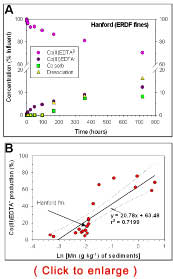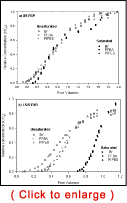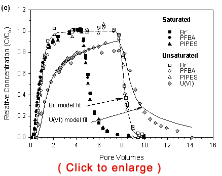Fate and Transport of Metals and Radionuclides in Semi-arid Vadose and Saturated Zones
Problem
- Nuclear weapons production at DOE’s Hanford site (in Richland WA) generated millions of gallons of high- and low-level radioactive waste, some of which have leaked into the vadose zone
- Vadose zone consists of complex and heterogeneous layering of unconsolidated sediments, experiences low recharge, and has low natural water content
- These conditions are present throughout the western U.S. at numerous contaminated sites
- Resultant subsurface distribution of radionuclides, toxic metals, and organic and inorganic contaminants is heterogeneous and is not adequately predicted given existing source data, hydraulic properties of sediments and expected geochemical reactivity.
- Anisotropy (i.e., directional-dependence) of the hydraulic properties of horizontal, layered sediments is also a major contributor to uncertainties in prediction of contaminant migration
Goals
To provide an improved conceptual understanding and quantitative basis for predicting the distribution and future mobility of contaminants
Objectives
- Investigate the influence of sedimentary heterogeneity upon metal transport using large intact cores that realistically reproduce conditions influencing contaminant migration in the subsurface.
- Intact cores retain the pore-scale heterogeneity of the porous media which consists of complex layered sediments at the mm-, cm-, and m-scales. Such heterogeneities are manifested in the resultant complex distribution of contaminants in the subsurface.
- Intact cores were taken in horizontal and vertical directions to quantify flow anisotropy. Anisotropy is defined as directionally-dependent hydraulic properties and contaminant transport.
- Experiments are long-term and use a multiple nonreactive tracer technique to elucidate mechanisms of preferential flow, matrix diffusion, with changing saturation.
- Uranium(VI), chelated Co, and Cr(VI) were target contaminants due to their toxicity (Cr(VI)), long half-life and radioactivity (U(VI)), and high mobility (Co-EDTA).
Methods
- Large intact core samples were collected in both vertical and horizontal orientations using a hydraulic-operated rotary coring device mounted to a front-end loader bucket (Figures 1 and 2), and by hand-sculpting (Figure 3).
- Cores were collected from seven different sedimentary units of distinct sedimentological characteristics in the Hanford area
- Ringold horizontally-bedded (White Bluffs)
- Ringold cross-bedded (White Bluffs)
- Plio-Pleistocene caliche (White Bluffs)
- Hanford laminated fine sands (Environmental Restoration Disposal Facility (ERDF) in 200W area)
- Hanford clastic dike sediments (Interim Disposal Facility (IDF) in 200E area)
- Hanford interbedded coarse/fine sands (IDF)
- Hanford coarse sands (IDF)
- Cores were encased in PVC pipe (Figure 4) and transported to the ORNL Unsaturated Flow Facility (Figure 5) for transport experimentation
Results and Discussion
- Predictive Relationship Between Sediment
Mineralogy and Contaminant Mobility
- Anisotropy of Saturated and Unsaturated Core Hydrology

- Uranium Mobility in Calcite-Rich Sediments

Heterogeneities in chemical or physical properties of subsurface media complicate our ability to make adequate predictions of contaminant mobility. We performed identical experiments using an approximately 20 different sediments from the Hanford Reservation (Figure A). The contaminant was Co(II)EDTA2-, a component of nuclear processing wastes produced from the association between radioactive 60Co and the organic chelate EDTA. It was found that some of the complex was oxidized to Co(III)EDTA- in the presence of Hanford sediments, and that the importance of the transformation was statistically correlated to the Mn-oxide content of the sediment (Figure B). The oxidative process is important because of the high degree of stability and mobility of the Co(III)EDTA- reaction product (log K = 40) in the subsurface environment. The significance of this study, however, lies in the generation of the relationship between Mn-oxides and Hanford sediments, which can be utilized to predict a priori the mobility of Co(II)EDTA2- given known sedimentary geochemical properties (Figure B). Such geochemical characterization exists for hundreds to thousands of samples from the Hanford Reservation.
The transport of multiple nonreactive tracers bromide (Br), pentafluorobenzoic acid (PFBA) and piperazine-1-4bis(2-ethanesulfonic acid) (PIPES) under saturated and unsaturated conditions through vertically(FXB)- and horizontally(FBP)-oriented cores of two units of Ringold Formation. Our experiments demonstrate significant differences in core hydrology from saturated to increasingly unsaturated conditions that are dependent upon sedimentary characteristics, water content, and flow direction. This suggests that subsurface heterogeneities which exist regarding all of these factors contributes to observed contaminant distributions. Our sizeable database of replicate core experiments provides quantitative data to improve current and future field-based predictions in the semi-arid western U.S.
The transport of uranium(VI) was investigated in an intact Plio-Pleistocene caliche core under unsaturated conditions. The retardation was significant (~3) and 10% irreversible, indicating geochemical reactivity with the sedimentary media. The subsurface caliche layer at Hanford is located approximately at the vadose zone-groundwater interface, and may act as a protective barrier for underlying groundwater. This study demonstrates that caliche material consisting primarily of amorphous silica and calcium carbonate with few iron oxides is capable of significant storage of U(VI). Caliche, limestone, and calcite-bearing subsurface sediments are common throughout the western U.S
Publications
- Ginder-Vogel, M., Borch, T., Mayes, M.A., Jardine, P.M., and Fendorf, S.E. 200_. Chromate reduction and retention processes within Hanford sediments (accepted by Environ. Sci. Tech.).
- Mayes, M.A., Yin, X.L., Pace, M.N., and Jardine, P.M. 2005. Rates and mechanisms of Co(II)EDTA2- interactions with sediments from the Hanford site. In: ACS Symposium Series 910: Biogeochemistry of Chelating Agents, Nowack, B. and Van Briesen, J., Eds., pp. 278-296.
- Mayes, M.A., Mehlhorn, T.L., and Jardine, P.M. 2005. Coupled hydrological and geochemical processes influencing the transport of chelated metals in the ORNL vadose zone and groundwater. In: ACS Symposium Series 910: Biogeochemistry of Chelating Agents, Nowack, B. and Van Briesen, J., Eds., pp. 297-315.
- Mayes, M.A., Pace, M. N., Jardine, P.M., Fendorf, S.E., Farrow, N.D., Yin, X.L, and Zachara, J.M. 2005. Coupled hydrological and geochemical processes governing the fate and transport of Sr and U in the Hanford vadose zone. In: ACS Symposium Series 904: Subsurface Contamination Remediation Accomplishments of the Environmental Management Science Program, Zachry, T., and Berkey, E., Eds., pp. 229-250.
- Mayes, M.A., Jardine, P.M., Mehlhorn, T.L., Bjornstad, B.N., Ladd, J.L., and Zachara, J.M. 2003. Transport of multiple tracers in variably saturated humid region structured soils and semi-arid region laminated sediments. J. Hydrol. 275: 141-161.
- Pace, M.N., Mayes, M.A., Jardine, P.M., Mehlhorn, T.L., Zachara, J.M., and Bjornstad, B.N. 2003. Quantifying the effects of small-scale heterogeneities on flow and transport in undisturbed cores from the Hanford formation. Vadose Zone J. 2: 664-676.
- Bostick, B.C., M.O. Barnett, P.M. Jardine, S.C. Brooks, S.E. Fendorf. 2002. Uranyl surface species formed on subsurface media from DOE facilities. Soil Science Society of America Journal 66:99-108.
- C.C. Ainsworth, F.J. Brockman, and P.M. Jardine. 2000. Vadose Zone State-of-the-Knowledge: Biogeochemistry. (In) Vadose Zone: Science and Technological Solutions (ed.) B.B. Looney and R.W. Falta. Battelle Press, Columbus, OH, volume II, p. 829-947.
Funding
DOE Environmental Management Science Program (1999-2002 Project 70219; 2002-2005 Project 86911) and Hanford site subcontractor CH2M Hill Hanford Group, Inc. (2005-open).
For more information, contact:
Melanie Mayes (mayesma@ornl.gov, 865-574-7336)
Philip Jardine (jardinepm@ornl.gov, 865-574-8058)

